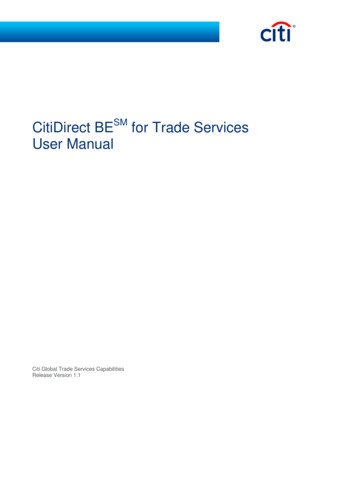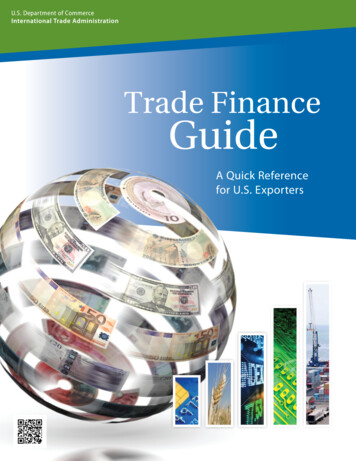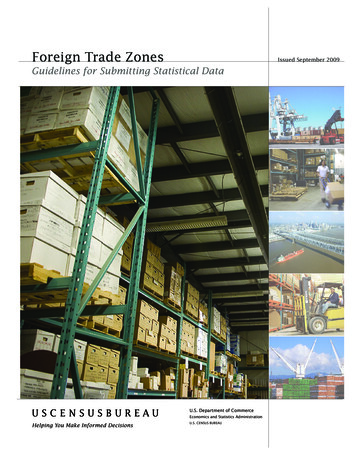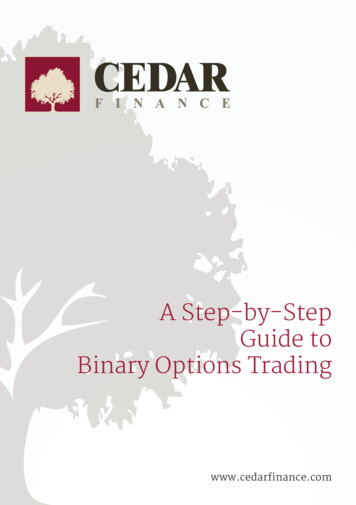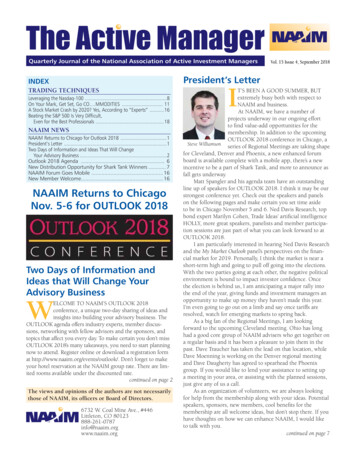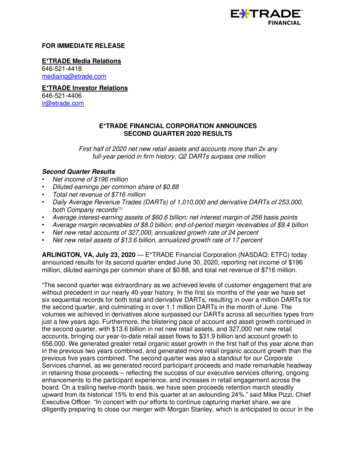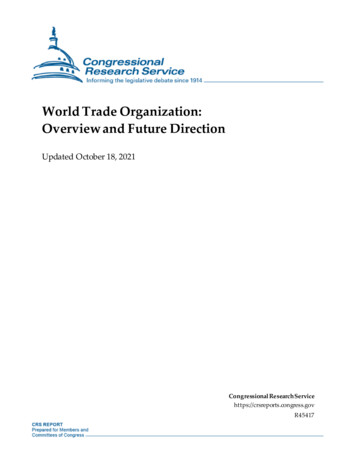
Transcription
World Trade Organization:Overview and Future DirectionUpdated October 18, 2021Congressional Research Servicehttps://crsreports.congress.govR45417
SUMMARYWorld Trade Organization:Overview and Future DirectionHistorically, U.S. leadership of the global trading system has ensured the United States a seat atthe table to shape the international trade agenda in ways that both advance and defend U.S.interests. The evolution of U.S. leadership and the global trading system remain of interest toCongress, which holds constitutional authority over foreign commerce and establishes U.S. tradenegotiating objectives through legislation. Congress has recognized the World TradeOrganization (WTO) as the “foundation of the global trading system” within the latest tradepromotion authority (TPA) and plays a direct legislative and oversight role over WTOagreements. The statutory basis for U.S. WTO membership is the Uruguay Round AgreementsAct (P.L. 103-465), and U.S. priorities and objectives for the General Agreement on Tariffs andTrade (GATT)/WTO have been reflected in various TPA legislation since 1974. Congress alsohas oversight of the U.S. Trade Representative and other agencies that participate in WTOmeetings and enforce WTO commitments.R45417October 18, 2021Cathleen D. Cimino-Isaacs,CoordinatorAnalyst in InternationalTrade and FinanceRachel F. FeferAnalyst in InternationalTrade and FinanceThe WTO is a 164-member international organization that was created to oversee and administer global trade rules, serve as aforum for trade liberalization negotiations, and resolve disputes. The United States was a major force behind theestablishment of the WTO in 1995, and the rules and agreements resulting from multilateral trad e negotiations since 1947.The WTO encompassed and succeeded the GATT, established in 1947 among the United States and 22 countries. Throughthe GATT and WTO, the United States, with other countries, sought to establish a more open, rules-based trading system inthe postwar era to foster international economic cooperation and prosperity. Today, 98% of global trade is among WTOmembers.The WTO is a consensus and member-driven organization. Its core principles include nondiscrimination (most-favorednation treatment and national treatment), freer trade, fair competition, transparency, and encouraging development. These areenshrined in WTO agreements covering goods, agriculture, services, intellectual property rights (IPR), and trade facilitation,among other issues. Many countries have been motivated to join the WTO not just to expand access to foreign markets, butalso to spur domestic economic reforms, transition to market economies, and promote the rule of law.The WTO dispute settlement (DS) mechanism provides an enforceable means for members to resolve disputes over WTOcommitments and obligations. The WTO has processed more than 600 disputes, and the United States has been an active userof the system. Supporters of the multilateral trading system consider the DS mechanism an important success, and anenforceable DS process was a priority negotiating objective for the United States in establishing the WTO. More recently,some members, notably the United States, contend it has procedural shortcomings and has exceeded its mandate in decidingcertain cases. The United States has thus vetoed appointments to the WTO’s Appellate Body (AB) and, in December 2019,the terms of remaining jurists expired, leaving the AB unable to function. This action could render the DS system ineffective,as appealed disputes remain pending resolution and members struggle to agree to solutions that address U.S. concerns.More broadly, many observers are concerned that the WTO’s effectiveness has diminished since the collapse of the DohaRound of multilateral trade negotiations, which began in 2001, and believe the WTO needs to negotiate new rules and adoptreforms to continue its role as the foundation of the trading system. To date, members have been unable to reach consensusfor a new comprehensive agreement on trade liberalization and rules. While global supply chains and technology havetransformed global trade and investment, WTO rules have not kept up with the pace of change. Many countries have turnedto negotiating free trade agreements outside the WTO and plurilateral agreements involving subsets of WTO members .The WTO’s 12th Ministerial Conference (MC12) is to be held in November 2021, after being postponed due to theCoronavirus Disease 2019 (COVID-19) pandemic. The biennial meeting, which usually involves active U.S. participation,has been widely anticipated as an action-forcing event for the WTO. At the previous ministerial in December 2017, no majordeliverables were announced, leaving the stakes high for MC12. Members have committed to finalize multilateral talks onfisheries subsidies and make progress on ongoing talks, such as e-commerce, while other areas remain largely stalled.Another potential deliverable involves a framework to better equip the WTO to support efforts against the COVID-19pandemic. In August 2021, the WTO reported a sustained rebound in global merchandise trade, after a sharp decline in globaltrade growth in 2020 in the aftermath of the pandemic. The WTO has committed to work to minimize disruptions to trade andCongressional Research Service
World Trade Organization: Overview and Future Directionglobal supply chains, and encouraged WTO members to notify trade restrictions and measures taken in response to COVID19, which surged in the beginning of 2020, causing concern for many observers. Some members have called on the WTO toaddress the trade policy challenges that emerged from COVID-19, such as through a dedicated “health and trade” initiative.Others are seeking an agreement among members to waive IPR related to vaccines and other medical products. Meanwhile,WTO members continue to explore broader aspects of reform and future negotiations. Potential reforms concern theadministration of the organization, its procedures and practices, dispute settlement, and attempts to address the inability ofWTO members to conclude new agreements. Among U.S. priorities are improving transparency and compliance with WTOnotification requirements and addressing the treatment of developing country status for members in future WTO negotiations.The Biden Administration has pledged to reengage in multilateral cooperation, be a leader in the WTO, and workconstructively towards reforms. Some U.S. government frustrations with the WTO are not new and are shared with othertrading partners. Under the previous Administration, U.S. actions to unilaterally raise tariffs under U.S. trade laws and toimpede the functioning of the WTO DS system raised concerns among some stakeholders about the U.S. commitment to themultilateral system and potential undermining of the WTO’s credibility.Ongoing debate over the role and future direction of the WTO is of interest to Congress. Some Members in the 117thCongress have expressed support for WTO reform efforts and U.S. leadership through resolutions, while others have beenskeptical of the merits of the WTO. Issues Congress may address include the effects of current and future WTO agreementson the U.S. economy and workers, the value of U.S. membership and leadership in the WTO, and the possibility ofestablishing new U.S. negotiating objectives or oversight hearings on prospects for WTO reforms and rulemaking. The WTOMinisterial Conference in 2021 presents the United States and WTO members with an opportunity to address pressingconcerns over ongoing and new negotiations, reform efforts, a nonfunctioning DS system, and the future role of themultilateral trading system more broadly, as members grapple with economic recovery from COVID-19 and other globalchallenges.Congressional Research Service
World Trade Organization: Overview and Future DirectionContentsIntroduction . 1Background. 2General Agreement on Tariffs and Trade (GATT) . 3World Trade Organization . 5Administering Trade Rules . 7Establishing New Rules and Trade Liberalization through Negotiations . 10Resolving Disputes . 11The United States and the WTO. 11WTO Agreements . 12Marrakesh Agreement Establishing the World Trade Organization. 12Multilateral Agreement on Trade in Goods (Annex 1A) . 13Agreement on Agriculture (AoA) . 14Trade-Related Investment Measures (TRIMS) . 14General Agreement on Trade in Services (GATS) (Annex 1B) . 15Agreement on Trade-Related Aspects of Intellectual Property Rights (TRIPS) (Annex1C) . 16Trade Remedies. 16Dispute Settlement Understanding (DSU) (Annex 2). 17Trade Policy Review Mechanism (Annex 3) . 20Plurilateral Agreements (Annex 4) . 21Government Procurement Agreement . 22Information Technology Agreement . 23Trade Facilitation Agreement. 23Key Exceptions under GATT/WTO. 24Joining the WTO: The Accession Process . 25China’s Accession and Membership . 26Current Status and Ongoing Negotiations . 29Buenos Aires Ministerial MC11, 2017 . 29Outlook for MC12, 2021 . 31Selected Ongoing WTO Negotiations . 32Agriculture . 32Fisheries Subsidies . 33Electronic Commerce/Digital Trade . 34Services . 35Environment. 37Policy Issues and Future Direction . 37COVID-19 and WTO Reactions. 39Negotiating Approaches. 40Plurilateral Agreements . 40Preferential Free Trade Agreements. 41Future Negotiations on Selected Issues . 43Competition with SOEs and Non-Market Practices . 44Investment . 45Proposed Institutional Reforms . 46Institutional Issues. 47Dispute Settlement . 50Congressional Research Service
World Trade Organization: Overview and Future DirectionSelected Challenges and Issues for Congress . 56Value of the Multilateral System and U.S. Leadership and Membership . 56Respect for the Rules and Credibility of the WTO . 57U.S. Sovereignty and the WTO. 58Role of Emerging Markets . 59Priorities for WTO Reforms and Future Negotiations . 60Outlook. 61FiguresFigure 1. WTO Structure. 7Figure 2. Uruguay Round Impact on Tariff Bindings. 9Figure 3. Average Applied Most-Favored Nation (MFN) Tariffs . 9Figure 4. WTO Dispute Settlement Procedure . 18Figure 5. WTO Disputes Involving the United States . 20Figure 6. WTO Accession Process . 26Figure 7. U.S. Trade in the WTO . 42TablesTable 1. Summary of GATT Negotiating Rounds . 4Table 2. Marrakesh Protocol to the GATT 1994 . 13ContactsAuthor Information . 62Congressional Research Service
World Trade Organization: Overview and Future DirectionIntroductionThe World Trade Organization (WTO) is an international organization that administers the traderules and agreements negotiated by its 164 members to eliminate trade barriers and createtransparent and nondiscriminatory rules to govern trade. It also serves as an important forum forresolving trade disputes. The United States was a major force behind the establishment of theWTO in 1995 and the rules and agreements that resulted from the Uruguay Round of multilateraltrade negotiations (1986-1994). The WTO encompassed and expanded on the commitments andinstitutional functions of the General Agreement on Tariffs and Trade (GATT), established in1947 by the United States and 22 other countries. Through the GATT and the WTO, the UnitedStates and others sought to establish a more open, rules-based trading system in the postwar era,with the goal of fostering international economic cooperation, stability, and prosperity worldwide.Today, the vast majority of world trade, 98%, takes place among WTO members.The evolution of U.S. leadership in the WTO and the institution’s future agenda have been ofinterest to Congress. The terms set by the WTO agreements govern the majority of U.S. tradingrelationships. The majority of U.S. global trade is with countries that do not have free tradeagreements (FTAs) with the United States, including China, the European Union (EU), India, andJapan, 1 and thus relies primarily on the terms of WTO agreements. Congress has recognized theWTO as the “foundation of the global trading system” within U.S. trade legislation and plays adirect legislative and oversight role over WTO agreements. 2 U.S. FTAs also build on core WTOagreements. While the U.S. Trade Representative (USTR) represents the United States at theWTO, Congress holds constitutional authority over foreign commerce and establishes U.S. tradenegotiating objectives and priorities and implements major U.S. trade agreements throughlegislation. U.S. priorities and objectives for the GATT/WTO are reflected in trade promotionauthority (TPA) legislation since 1974. Congress also has oversight of the USTR and otherexecutive branch agencies that participate in WTO meetings and enforce WTO commitments.The WTO’s effectiveness as a negotiating body for broad-based trade liberalization has comeunder intensified scrutiny, as has its role in resolving trade disputes. WTO members havestruggled to reach consensus over issues that can place developed country members againstdeveloping country members (such as agricultural subsidies, industrial goods tariffs, andintellectual property rights protection). The institution has also struggled to address newer tradebarriers, such as digital trade restrictions and the role of state-owned enterprises in internationalcommerce, which have become more prominent issues in recent years. Global supply chains andadvances in technology have transformed global commerce, but trade rules have failed to keep upwith the pace of change; since 1995, WTO members have been unable to reach consensus for anew comprehensive multilateral agreement. As a result, many have turned to negotiating FTAswith one another outside the WTO to build on core WTO agreements; in some of these bilateraland regional agreements, including those pursued by the United States and EU, newer rules mayvary significantly. Plurilateral negotiations, involving subsets of WTO members rather than allmembers, are also becoming a popular forum for tackling newer issues on the trade agenda.The most recent round of WTO negotiations, the Doha Round, began in November 2001, butconcluded with no clear path forward, leaving several unresolved issues after the 10th MinisterialConference in 2015. Efforts to build on current WTO agreements outside of the Doha agendacontinue. While WTO members have made some progress, no major deliverables were announcedat the last Ministerial in 2017, leaving the stakes high for the next meeting in November 2021.12T he United States has a partial trade agreement with Japan covering some goods liberalization and digital trade rules.Section 102(b)(13), Bipartisan Congressional T rade Priorities and Accountability Act of 2015 (T itle I, P.L. 114-26).Congressional Research Service1
World Trade Organization: Overview and Future DirectionMembers were forced to reschedule the Ministerial from 2020 due to the Coronavirus Disease2019 (COVID-19) pandemic. COVID-19 has tested cooperation and coordination in global tradepolicies, disrupted global supply chains, and spurred some trade protectionism. At the same time,several countries have reaffirmed the trading system, lifted restrictions, and view the WTO asplaying an important role in tackling the trade policy challenges that have emerged.The Biden Administration has pledged to reengage in multilateral cooperation, be a leader in theWTO, and work constructively towards reforms.3 A key question for Congress is defining U.S.priorities under the Administration for improving the multilateral trading system. Under theprevious Administration, overall skepticism of the value of the WTO institution, 4 and actions tounilaterally raise tariffs under U.S. trade laws and to impede the functioning of the DS system hadraised questions among some stakeholders about U.S. leadership and potentially undermining theWTO’s credibility. Observers remain concerned that China’s statist trade and investmentpractices as the top global trader are stressing the current WTO system and related rules andprinciples of free trade. Some say that the U.S. policy response so far to China concerns—such asU.S. tariff actions and China’s counterretaliation—are further straining the system. Unresolvedtrade disputes between major economies, including between the United States and EuropeanUnion, have strained the trading system. In the near term, the WTO is faced with resolvingpending disputes, many of which involve the United States, as well as debate about the role of itsAppellate Body.At the same time, many U.S. fundamental concerns regarding the WTO predate the TrumpAdministration and are shared by other trading partners. The United States remains committed toreform of the trading system and is engaged in several WTO negotiations and initiatives. USTRTai has emphasized that a “successful” ministerial in November must deliver on a meaningfulagreement on fisheries subsidies, members’ response to the COVID-19 pandemic, and theimportance of WTO reform.5With growing debate over the role and future direction of the WTO, Congress may have interestin several issues, including: the value of U.S. membership and leadership in the WTO, thepossibility of establishing new U.S. trade negotiating objectives, or holding oversight hearings toaddress prospects of new WTO reforms and rulemaking. This report provides background historyof the WTO, its organization, and current status of negotiations and reform efforts. The reportalso explores concerns regarding the WTO’s future direction and key policy issues for Congress.BackgroundFollowing World War II, countries throughout the world, led by the United States and severalother developed countries, sought to establish a more transparent and nondiscriminatory tradingsystem with the goal of raising the economic well-being of all countries. Aware of the role of titfor-tat trade barriers resulting from the U.S. Smoot-Hawley tariffs in exacerbating the economicdepression in the 1930s, including severe drops in world trade, global production, and3UST R, 2021 Trade Policy Agenda and 2020 Annual Report, March 31, 2021.White House, “Remarks by President T rump to the 74 th Session of the United Nations General Assembly,” September25, 2019, eneral-assembly/.4UST R, “ Readout of Ambassador Katherine T ai’s meeting with World T rade Organization Director -General Dr. NgoziOkonjo-Iweala,” September 22, 2021.5Congressional Research Service2
World Trade Organization: Overview and Future Directionemployment, the countries that met to discuss the new trading system considered more open tradeas essential for peace and economic stability. 6The intent of these negotiators was to establish an International Trade Organization (ITO) toaddress not only trade barriers but other issues indirectly related to trade, including employment,investment, restrictive business practices, and commodity agreements. Unable to secure approvalfor such a comprehensive agreement, however, they reached a provisional agreement on tariffsand trade rules, known as the GATT, which went into effect in 1948. 7 This provisional agreement,subject to several rounds of trade liberalization negotiations, became the principal set of rulesgoverning international trade for the next 47 years, until the establishment of the WTO.General Agreement on Tariffs and Trade (GATT)The GATT was neither a formal treaty nor an international organization, but an agreementbetween governments, to which they were contracting parties. The GATT parties established asecretariat based in Geneva, but it remained relatively small, especially compared to the staffs ofinternational economic institutions created by the postwar Bretton Woods conference—theInternational Monetary Fund and World Bank. Based on a mission to promote trade liberalization,the GATT became the principal set of rules and disciplines governing international trade.The core principles and articles of the GATT(which were carried over to the WTO)committed the original 23 members, includingMost-favored nation (MFN) treatment (alsothe United States, to lower tariffs on a range ofcalled normal trade relations by the United States).industrial goods and to apply tariffs in aRequires each member country to grant each othermember country treatment at least as favorable as itnondiscriminatory manner—the so-calledgrants to its most-favored trade partner.most-favored nation or MFN principle (see textNational treatment. Obligates each country not tobox). By having to extend the same benefitsdiscriminate between domestic and foreign products;and concessions to members, the economiconce an imported product has entered a country, thegains from trade liberalization were magnified.product must be treated no less favorably than aExceptions to the MFN principle were allowed,“like” product produced domestically.however, including for preferential tradeagreements outside the GATT/WTO covering “substantially” all trade among members and fornonreciprocal preferences for developing countries. 8 GATT members also agreed to provide“national treatment” for imports from other members. For example, countries could not establishone set of health and safety regulations on domestic products while imposing more stringentregulations on imports.GATT/WTO Principlesof NondiscriminationAlthough the GATT mechanism for the enforcement of these rules or principles was generallyviewed as largely ineffective, the agreement nonetheless brought about a substantial reduction oftariffs and other trade barriers. 9 The eight “negotiating rounds” of the GATT succeeded inBarry Eichengreen and Douglas A. Irwin, “T he Slide to Protectionism in the Great Depression: Who Succumbed andWhy?” The Journal of Economic History, vol. 70, no. 4 (December 2010), pp. 871-897.7 One major reason the IT O lost momentum was the U.S. government’s announcement in 1950 that it would no longerseek congressional ratification of the IT O Charter, due to opposition in the U.S. Congress. WT O, “T he GAT T years:from Havana to Marrakesh,” https://www.wto.org/english/thewto e/whatis e/tif e/fact4 e.htm.68GAT T Article XXIV. For more information see CRS Report R45198, U.S. and Global Trade Agreements: Issues forCongress, by Brock R. Williams.For more detail on perceived shortcomings of GAT T dispute settlement, see “Historic development of the WT Odispute settlement system,” https://www.wto.org/english/tratop e/dispu e/disp settlement cbt e/c2s1p1 e.htm.9Congressional Research Service3
World Trade Organization: Overview and Future Directionreducing average tariffs on industrial products from between 20%-30% to just below 4%, andlater establishing agreements to address certain non-tariff barriers, facilitating a 14-fold increasein world trade over its 47-year history (see Table 1). 10 When the first round concluded in 1947, 23countries had participated, which accounted for a majority of global trade at the time. When theUruguay Round establishing the WTO concluded in 1994, 123 countries had participated and theamount of trade affected was nearly 3.7 trillion. There are currently 164 WTO members andtrade flows totaled 22 trillion in 2020. 11Table 1. Summary of GATT Negotiating RoundsRound(Year: Location)NegotiatingCountries (#)1947: Geneva, Switzerland23MajorAccomplishments GATT established Tariff reduction of about 20% negotiated1949: Annecy, France13 Accession of 11 new contracting parties Tariff reduction of about 2%1950-51: Torquay, UK38 Accession of 7 new contracting parties Tariff reduction of about 3%1955-56: Geneva26 Tariff reduction of about 2.5%1960-61: Geneva (Dillon)26 Tariff reduction of about 4% and negotiationsinvolving the external tariff of the EuropeanCommunity1964-67: Geneva (Kennedy)62 Tariff reduction of about 35% Negotiation of antidumping measures1973-79: Geneva (Tokyo)102 Tariff reduction of about 33% Several nontariff barrier codes negotiated,including subsidies, customs valuation, standards,and government procurement1986-1994: Geneva (Uruguay)123 WTO created a new dispute settlement system Liberalization of agriculture, textiles, and apparel Rules adopted in new areas such as services, traderelated investment, and intellectual propertySources: Douglas A. Irwin, Free Trade Under Fire, p. 225, and Stephen D. Cohen et al., Fundamentals of U.S.Foreign Trade Policy, p. 185.During the first trade round held in Geneva in 1947, members negotiated a 20% reciprocal tariffreduction on industrial products, and made further cuts in subsequent rounds. The Tokyo Roundrepresented the first attempt to reform the trade rules that had existed unchanged since 1947, byincluding issues and policies that could distort international trade. As a result, Tokyo Roundnegotiators established several plurilateral codes dealing with nontariff issues such asantidumping, subsidies, standards or technical barriers to trade, import licensing, customsvaluation, and government procurement.12 Countries could choose which, if any, of these codes10WT O, World Trade Report 2007, pp. 201-209.11WT O, World Trade Statistical Review 2021.12WT O, “Pre-WTO legal texts,” https://www.wto.org/english/docs e/legal e/prewto legal e.htm.Congressional Research Service4
World Trade Organization: Overview and Future Directionthey wished
negotiating objectives through legislation. Congress has recognized the World Trade Organization (WTO) as the “foundation of the global trading system” within the latest trade promotion authority (TPA) and plays a direct legislative and oversight role over WTO agreements. The statuto
